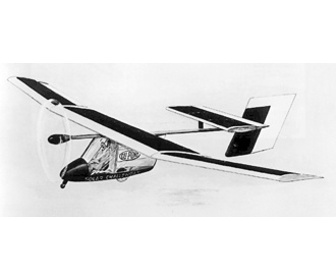Solar Challenger

Solar Challenger was a solar-powered electric aircraft designed by Paul MacCready's AeroVironment. The aircraft was designed as an improvement on the Gossamer Penguin which in turn was a solar-powered variant of the human-powered Gossamer Albatross. It was powered entirely by the photovoltaic cells on its wing and stabilizer without even reserve batteries and was the first such craft capable of long-distance flight.
In 1981, the rugged Solar Challenger was piloted
163 miles from Paris, France to England, at an altitude of 11,000
feet.1
1981: MacCready’s Solar Challenger was the first solar aircraft to
fly across the English Channel.2
The Solar Challenger had a wingspan of 14.3 meters
(47 feet) and a weight of 90 kilograms (200 pounds).3
Solar Challenger had no batteries; it
collected sufficient energy from sunlight—4,400 watts—to take off,
climb to 14,000 feet, and cruise at 40 mph.4
Paul MacReady's famous "Dupont Solar Challenger" that made the
historic
English Channel crossing flight on July 8th 1981.5
MacCready the Solar Challenger set an altitude record of 14,300 feet.6
first plane powered entirely by the sun, the Solar Challenger, which
in 1981 flew the 163 miles from Paris to Canterbury at a height of
11,000 feet. “Flying on sunbeams”, he liked to call it.7
The airfoil used on the Solar Challenger, an aircraft that flew across
the English Channel on solar power, was designed with an totally flat
upper surface so that solar cells could be easily mounted.8
The Solar Challenger was the first solar powered aircraft capable of
long distance flights.9
MacCready's Solar Challenger flew across the English Channel, and in
2001 NASA's Helios unmanned solar-powered vehicle achieved an altitude
of nearly 97,000 ft.10
Made by AeroVironment.
It is the successor of the Gossamer Penguin .
They are spinoffs of his Solar Challenger, a plane that in
1981 made the first long-distance piloted flight powered solely by
sunbeams.11
1981 an improved version, Solar Challenger, flew from Paris to
Canterbury, a distance of 163 miles, attaining an altitude of
11,000ft.12
Solar Challenger Solar powered aircraft that flew from Paris to
London.
White Dwarf A human powered lighter-than-air craft.13
The Solar Challenger had a wingspan of 14.3 meters (47
feet) and a weight of 200lbs (90kg).14
There was no prize involved in the Solar Challenger (it was again
funded by DuPont), only the satisfaction of achieving the seemingly
impossible.15
MacCready's Solar Challenger is first solar-powered
aircraft to cross English Channel.
Dec. 14-23, 1986.16
the Gossamer Penguin and Solar Challenger vehicles in the late 1970s
and early 1980s, following the pioneering work of Robert Boucher, who
built the first solar-powered flying models in 1974.17
powered aircraft was the Solar Challenger which flew in 1981. The
Solar Challenger was an experimental aircraft and wasn't practical for
everyday use.18
His Solar Challenger, in 1981, set records for
highest, farthest and longest solar-powered manned flight.19
* In 1981 the Solar Challenger took to the skies, and flew from
France to England – 163 miles.20
Empty Weight Lb
200
Designer
Paul MacCready
Predecessor
Gossamer Penguin
Eng 1 Type
solar-powered electric motors
Max Speed Mph
40
Ceiling Ft
14000
Eng 1 Kw
2
Status
Developed From
Gossamer Penguin
Span Ft
47
Number Built
1
Crew
One
Climb Rate Ftmin
150
Empty Weight Kg
90
Span M
14
Climb Rate Ms
1
Manufacturer
First Flight
1981
Max Speed Kmh
64
Origin
United States
National Origin
United States
Met Or Eng
eng
Length Ft
29
Ceiling M
4270
Eng 1 Hp
3
Eng 1 Number
2
Related
* Gossamer Penguin
Length M
9
Category
